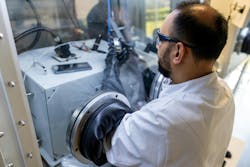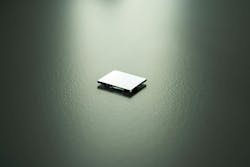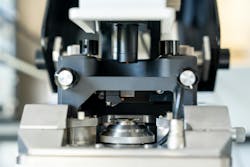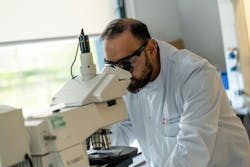Quantum materials are revolutionizing imaging and sensing
Applications long dominated by expensive, bulky technology are now becoming possible at a fraction of the price. From machine vision to gas detection, sensors that tap into infrared (IR) wavelengths are growing more accessible by the day, enabling cameras to “see” beyond the visible and harness vast quantities of data. As demand for IR sensing grows over the next decade, the technology powering this breakthrough—quantum dots (QDs)—is only becoming more advanced, bringing high-performance capability hurtling into the market.
The quantum revolution is truly underway.
What are QDs?
QDs are nanoscale semiconducting materials that absorb and emit different wavelengths of light depending on their size. The key to controlling QD growth is how they are produced. Most are made using long-chain organic ligand exchange, which helps them to keep their colloidal stability when immersed in solvents. Because they measure just a few atoms wide, QDs benefit from an increased quantum confinement effect. In principle, this means QDs act as a small semiconductor box and, as the size of this box shrinks, the quantum confinement effect increases and band gap between the valence state and conduction band is increased. Tuning the size of QDs results in extremely tunable absorption and emission wavelengths.
High-performance QDs can be tuned to absorb and emit light all the way from the visible, through near- and short-wave IR (NIR and SWIR) to mid-wave IR (MWIR). This grants them unmatched flexibility across multiple spectra and outstanding sensitivity, particularly for SWIR sensing applications—matching or surpassing the best widely available alternatives.
Smaller size, lower cost
QDs can be produced at kilogram scale and still offer the level of performance required for imaging and sensing applications. Modern QD synthesis removes the requirement to deposit the materials in 14 to 16 layers, with sequential chemical “spin-coating” treatments between each stage.
Instead, QD surface-treated ink can be deposited in a single layer. This eliminates the need for extensive chemical processing and minimizes the risk of defects such as cracking or inefficient exchange processes that occur in the films that plague other deposition methods.
Using this strategy for QD deposition significantly cuts the time and waste involved in production. As a result, high-performance QD ink can be produced at a cost-effective scale.
To date, indium-gallium-arsenide (InGaAs) has dominated SWIR sensing and imaging applications due to the high performance it offers. But InGaAs is not without its drawbacks: it often costs up to $10,000 per unit. This price is inflated due to the high rate of defects that occur during batch production, which is something that QDs easily overcome.
InGaAs sensors are created by growing the material directly onto indium phosphide (InP) wafers, which are diced into chips. Pixels are then indium bonded with silicon readout circuits, but it results in limited pixel pitch and resolution, and the fragility of InP materials makes it challenging to create larger wafers. Copper-copper hybrid wafer bonding technology offers an alternative production method, but results in sensors that are even more susceptible to noise due to the high dark current they experience at room temperatures.
Bulky cooling systems are also required to ensure these systems can deliver required performance standards, which further increases the cost of production. Combined, this means that QDs often cost anywhere between 100 and 1000x less than equivalent InGaAs solutions, but they still offer comparable or superior performance for imaging and sensing.
Practical applications
In many ways, SWIR acts like visible light. Where it differs is in its response to certain substances like water and plastic. For example, some SWIR wavelengths are absorbed by water, which produces dark areas on images captured by a SWIR camera, and some plastics and silicon appear transparent under SWIR light.
These characteristics grant SWIR outstanding applications for machine vision. Cameras that integrate SWIR QD technology can be used to monitor fill levels inside opaque plastic containers or detect subdermal bruising in food with high water content, because any bruises will appear darker than the surrounding area under SWIR light.
SWIR sensors powered by QDs can also help companies to protect their workforce and reduce their environmental impact by enabling high-performance gas detection. As demand for air pollution monitoring equipment grows, driven by the increasing recognition of the dangers posed by gases like methane (CH4), many companies are seeking low-cost, lightweight solutions to help them identify where emissions are occurring.
Hyperspectral imaging is an invaluable tool for this application. The absorption characteristics of CH4 make it easily identifiable under SWIR light, which ensures detectors can pick up even small traces. The high quantum efficiency of SWIR QD detectors and low read noise at room temperature further enhance its effectiveness as a monitoring solution.
Researchers are experimenting with using QDs to sense gas in a different way. Many gas sensors used today use nanostructured metal oxides due to their high surface-to-volume ratio and reactivity, but they suffer from limited selectivity and require high temperatures to work effectively. The large effective surface-to-volume ratio of QDs results in high chemical reactivity with certain chemicals, which creates effective chemiresistors with resistance linked to the concentration of the gas being measured for. And the outstanding processability of QDs means they are suitable for use on a range of different substrates.
Bringing QDs into the mainstream
One of the most common barriers to widespread QD rollout is the inherent toxicity of the highest-performing materials. Most QDs include heavy metals such as lead or cadmium to maximize their efficiency, but these elements are restricted for use by leading manufacturers and subjected to potential future regulation restrictions. Alternative formulations are available that substitute heavy metals for materials like indium, but they struggle to match the performance of traditional solutions.
The best-performing lead-free QDs are sensitive to wavelengths up to approximately 1550 nm and provide suitable non-lead QD alternatives for a wide range of SWIR sensing applications.
QD technology is not some distant, far-off concept—it is already being used for multiple machine-vision applications today, which provide a low-cost alternative to existing InGaAs sensors. QD-based devices have been created with small global shutter, with high performance and low production costs. As the technology advances, IR QD technology will become even more accessible and bring SWIR sensing capability into the mass market.
About the Author
Hao Pang
Hao Pang is the CEO and founder of Quantum Science (QS; Daresbury, U.K.), an infrared technology company that develops and commercializes infrared quantum dot (QDs), nanomaterials, and technologies for infrared imaging and sensing markets. QS has a team of experts in QD synthesis and scaleup, nanocrystal and nanoparticle surface engineering, ink formulation, thin-film processing, and QD semiconductor device engineering.




